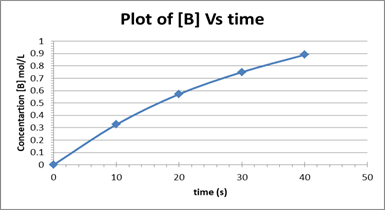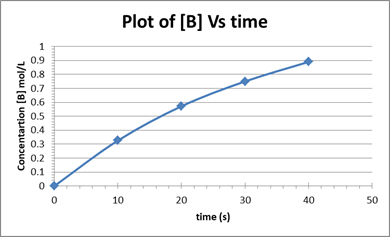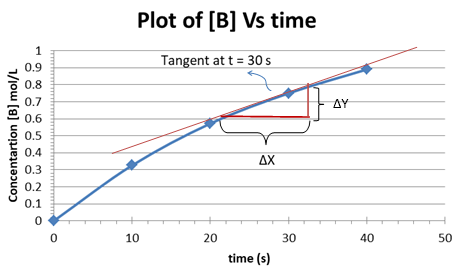
Experimental data are listed here for the reaction ![Chapter 11, Problem 11.20PAE, Experimental data are listed here for the reaction B: Time (s) IB] (mol/L) 0.00 0.000 10.0 0.326](https://content.bartleby.com/tbms-images/9781337398909/Chapter-11/images/html_98909-11-11.20pae_image001.jpg) B:
B:
| Time (s) | IB] (mol/L) |
| 0.00 | 0.000 |
| 10.0 | 0.326 |
| 20.0 | 0.572 |
| 30.0 | 0.750 |
| 40.0 | 0.890 |
- Prepare a graph from these data, connect the points with a smooth line, and calculate the rate of change of [B] for each 10-s interval from 0.0 to 40.0 s. Does the rate of change decrease from one time interval to the next? Suggest a reason for this result.
- How is the rate of change of [AJ related to the rate of change of [B] in each time interval? Calculate the rate of change of [AJ for the time interval from 10.0 to 20.0 s.
- What is the instantaneous rate, A[B]/Ar, when [BI = 0.750 mol/L?
a)
Interpretation:
A graph based on the given data must be plotted and the rate of change of [B] for every 10 s interval must be calculated.
Concept Introduction:
- Chemical reactions proceed at a certain rate which is represented in terms of the change in concentration over a certain period of time
- The rate can be expressed either in terms of a decrease in concentration of the reactants or an increase in the concentration of products.
Answer to Problem 11.20PAE
Solution:
The plot is depicted below.

The rate of change of [B] decreases from one-time interval to the next.
Explanation of Solution
The given reaction is:
A plot of concentration of [B] vs time based on the given data is shown below:

As per the above calculations, the rate of change decreases from one-time interval to the next. This is because as time increases the concentration of reactants decreases as a result the rate of formation of the products will also decrease.
(b)
Interpretation:
The relation between the rate of change of [A] and the rate of change of [B] must be explained. The rate of change of [A] for the time interval from 10.0 to 20.0 s should be calculated.
Concept Introduction:
- Chemical reactions proceed at a certain rate which is represented in terms of the change in concentration over a certain period of time
- The rate can be expressed either in terms of a decrease in concentration of the reactants or an increase in the concentration of products.
Answer to Problem 11.20PAE
Solution:
The rate of change of A is half that of B and for time interval 10 to 20 s rate of change of [A] is
Explanation of Solution
The given reaction is:
Based on the stoichiometry of this reaction, the rate can be expressed as:
For the time interval between t = 10 to t = 20 s:
(c)
Interpretation:
The instantaneous rate must be calculated when [B] = 0.750 mol/L
Concept Introduction:
- Chemical reactions proceed at a certain rate which is represented in terms of the change in concentration over a certain period of time
- The rate can be expressed either in terms of a decrease in concentration of the reactants or an increase in the concentration of products.
- Average rate of a reaction can be defined as the difference in the concentrations measured at two different times whereas, instantaneous rate can be defined as the rate of a reaction at a particular instant in time.
Answer to Problem 11.20PAE
Solution: Rate = 0.200 mol/L-s
Explanation of Solution
Instantaneous rate can be deduced by drawing a tangent at the point of the curve that corresponds to a particular instant. The slope of the tangent gives the instantaneous rate. In this case the value of [B] = 0.075 mol/L corresponds to a time t = 30 sec. The tangent and the slope are depicted in the plot shown below:

Therefore, the instantaneous rate is
Want to see more full solutions like this?
Chapter 11 Solutions
Chemistry for Engineering Students
- wrtie the balanced equation and find the E° when the following half- reactions are combined Zn2+(aq) + 2e---> Zn(s) E°= -0.763V Ag+(aq) + e---> Ag (s) E°=+0.799Varrow_forwardConsider this molecule: How many H atoms are in this molecule? How many different signals could be found in its 'H NMR spectrum? Note: A multiplet is considered one signal. ☐arrow_forwardStudy this 'H NMR spectrum, and then answer the questions about it in the table below. Check 1.0- 0.5- 0.0 10.0 9.0 8.0 7.0 6.0 5.0 4.0 3.0 2.0 1.0 0.0 What unit symbol should be written on the horizontal axis? What is the chemical shift & of the doublet? If there is no doublet, just check the box instead. Give your answer to 2 significant digits. What is the chemical shift of the signal immediately upfield of the doublet? If there is no doublet, or no signal upfield of it, check the box instead. What is the chemical shift & of the least deshielded proton? If you can't tell without more information, check the box instead. 血 8 = ☐ There is no doublet. 8 = ☐ No such signal. 8 = 0 Need more information.arrow_forward
- how many moles of H2O2 are required to react with 11g of N2H4 according to the following reaction? (atomic weights: N=14.01, H=1.008, O= 16.00) 7H2O2 + N2H4 -> 2HNO3 + 8H20arrow_forwardcalculate the number of moles of H2 produced from 0.78 moles of Ga and 1.92 moles HCL? 2Ga+6HCL->2GaCl3+3H2arrow_forwardan adult human breathes 0.50L of air at 1 atm with each breath. If a 50L air tank at 200 atm is available, how man y breaths will the tank providearrow_forward
- Using reaction free energy to predict equilibrium composition Consider the following equilibrium: 2NO2 (g) = N2O4(g) AGº = -5.4 kJ Now suppose a reaction vessel is filled with 4.53 atm of dinitrogen tetroxide (N2O4) at 279. °C. Answer the following questions about this system: Under these conditions, will the pressure of N2O4 tend to rise or fall? Is it possible to reverse this tendency by adding NO2? In other words, if you said the pressure of N2O4 will tend to rise, can that be changed to a tendency to fall by adding NO2? Similarly, if you said the pressure of N2O4 will tend to fall, can that be changed to a tendency to '2' rise by adding NO2? If you said the tendency can be reversed in the second question, calculate the minimum pressure of NO 2 needed to reverse it. Round your answer to 2 significant digits. 00 rise ☐ x10 fall yes no ☐ atm G Ar 1arrow_forwardWhy do we analyse salt?arrow_forwardCurved arrows are used to illustrate the flow of electrons. Using the provided starting and product structures, draw the curved electron-pushing arrows for the following reaction or mechanistic step(s). Be sure to account for all bond-breaking and bond-making steps. H H CH3OH, H+ H Select to Add Arrows H° 0:0 'H + Q HH ■ Select to Add Arrows CH3OH, H* H. H CH3OH, H+ HH ■ Select to Add Arrows i Please select a drawing or reagent from the question areaarrow_forward
 ChemistryChemistryISBN:9781305957404Author:Steven S. Zumdahl, Susan A. Zumdahl, Donald J. DeCostePublisher:Cengage Learning
ChemistryChemistryISBN:9781305957404Author:Steven S. Zumdahl, Susan A. Zumdahl, Donald J. DeCostePublisher:Cengage Learning
 Chemistry & Chemical ReactivityChemistryISBN:9781337399074Author:John C. Kotz, Paul M. Treichel, John Townsend, David TreichelPublisher:Cengage Learning
Chemistry & Chemical ReactivityChemistryISBN:9781337399074Author:John C. Kotz, Paul M. Treichel, John Townsend, David TreichelPublisher:Cengage Learning Chemistry & Chemical ReactivityChemistryISBN:9781133949640Author:John C. Kotz, Paul M. Treichel, John Townsend, David TreichelPublisher:Cengage LearningChemistry: Matter and ChangeChemistryISBN:9780078746376Author:Dinah Zike, Laurel Dingrando, Nicholas Hainen, Cheryl WistromPublisher:Glencoe/McGraw-Hill School Pub Co
Chemistry & Chemical ReactivityChemistryISBN:9781133949640Author:John C. Kotz, Paul M. Treichel, John Townsend, David TreichelPublisher:Cengage LearningChemistry: Matter and ChangeChemistryISBN:9780078746376Author:Dinah Zike, Laurel Dingrando, Nicholas Hainen, Cheryl WistromPublisher:Glencoe/McGraw-Hill School Pub Co Chemistry: An Atoms First ApproachChemistryISBN:9781305079243Author:Steven S. Zumdahl, Susan A. ZumdahlPublisher:Cengage Learning
Chemistry: An Atoms First ApproachChemistryISBN:9781305079243Author:Steven S. Zumdahl, Susan A. ZumdahlPublisher:Cengage Learning





